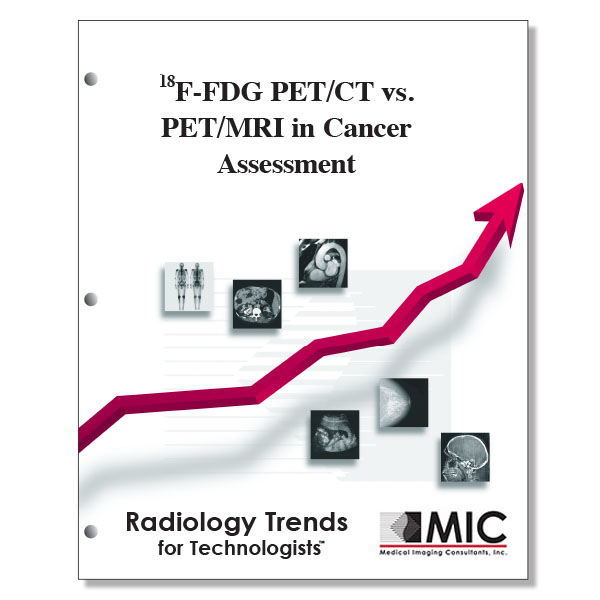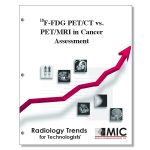

18F-FDG PET/CT vs. PET/MRI in Cancer Assessment
PET/MRI scanners are introduced and probed for their ability to improve cancer assessment relative to PET/CT.
Course ID: Q00491 Category: Radiology Trends for Technologists Modalities: CT, MRI, Nuclear Medicine, PET, Radiation Therapy1.75 |
Satisfaction Guarantee |
$24.00
- Targeted CE
- Outline
- Objectives
Targeted CE per ARRT’s Discipline, Category, and Subcategory classification for enrollments starting after February 14, 2023:
[Note: Discipline-specific Targeted CE credits may be less than the total Category A credits approved for this course.]
Computed Tomography: 0.75
Procedures: 0.75
Head, Spine, and Musculoskeletal: 0.25
Neck and Chest: 0.25
Abdomen and Pelvis: 0.25
Magnetic Resonance Imaging: 0.75
Procedures: 0.75
Neurological: 0.25
Body: 0.25
Musculoskeletal: 0.25
Nuclear Medicine Technology: 1.00
Procedures: 1.00
Endocrine and Oncology Procedures: 1.00
Registered Radiologist Assistant: 1.00
Procedures: 1.00
Abdominal Section: 0.25
Thoracic Section: 0.25
Musculoskeletal and Endocrine Sections: 0.25
Neurological, Vascular, and Lymphatic Sections: 0.25
Sonography: 0.50
Procedures: 0.50
Abdomen: 0.25
Gynecology: 0.25
Radiation Therapy: 0.75
Patient Care: 0.75
Patient and Medical Record Management: 0.75
Outline
- Introduction
- Design of PET/MRI Systems
- Operational Considerations
- Clinical Indications for PET/MRI
- Head and Neck Cancer
- Lung Cancer and Pulmonary Lesions
- Gastrointestinal Cancer
- Gynecologic Cancer
- Breast Cancer
- Prostate Cancer
- Lymphoma
- Neuroendocrine Tumors
- Metastatic Bone Disease
- Pediatric Cancer
- Central Nervous System Tumors
- Mixed-Cancer Populations
- Summary and Future Perspectives
Objectives
Upon completion of this course, students will:
- identify the most important reason driving the success of PET/CT after integrated scanners became commercially available in 2000
- describe the primary focus of studies comparing PET/MRI and 18F-FDG PET/CT
- list the PET/MRI system designs that allow the individual modality components to be used independently
- list the PET/MRI system designs that allow for reduced imaging time and the least amount of image misregistration
- list the classes of tissue segmentation provided by MRI-based attenuation correction sequences
- understand the prerequisites for clinical adoption of PET/MRI
- identify the superiority of PET/MRI over PET/CT in prostate cancer
- describe the role of CT and MRI as first-line imaging modalities according to NCCN guidelines
- list the imaging modalities supported by NCCN guidelines for staging and restaging of head and neck cancer patients
- recognize the stages of small cell lung cancer for which 18F-FDG PET/CT is appropriate for additional work-up
- describe the size threshold of 18F-FDG-negative lung nodules that limits detection by PET/MRI
- identify the recommended imaging modality for T-staging of esophageal cancer
- identify the imaging modality that demonstrates the highest accuracy for N-staging of esophageal cancer
- identify the first-line imaging modality listed by NCCN guidelines for liver metastases of colorectal cancer
- list the imaging modalities used for initial diagnosis of uterine, ovarian, and cervical cancers
- describe the clinical settings in which MRI is considered for staging of breast cancer patients
- describe the use of PET/CT for staging of breast cancer
- understand the application of multiparametric MRI in the evaluation of recurrent prostate cancer
- list the PET tracers used in conjunction with PET/CT to identify sites of metastatic prostate cancer
- describe the diagnostic modality of choice for lymphomas that are not routinely 18F-FDG-avid
- compare the sensitivities of DWI, PET/MRI and PET/CT in the identification of 18F-FDG-avid nodal groups
- identify the imaging technique that is considered the standard of care for assessing neuroendocrine tumor patients
- compare the sensitivities of imaging modalities for the detection of early bone lesions and marrow-based metastases
- describe the body region were lesion detection rates with PET/CT are slightly better than those with PET/MRI
- identify the imaging modality that is considered to be the gold standard for imaging central nervous system cancer
